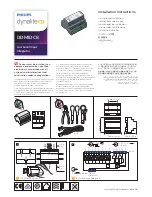
iPECS SBG-1000 User Manual (IP-PBX Features)
3-24
3.2.2.3
Call Routing by Caller Number
The system can employ Incoming Calling Line ID (ICLID) to determine the routing of incoming
external calls. The system will compare the received ICLID, and if a match is found, will route the
call to the destination defined in the Ring Assignment Table index.
Table 3.2.2.3 Call Routing by Caller Number
ATTRIBUTE
DESCRIPTION
RANGE
DEFAULT
Caller Number
ICLID (Incoming Caller ID) to match for the index. If
the Caller ID matches the Table entry, the index is
used to select the route.
23 Digits
None
Caller Name
ICLID name that is sent by the system to the
destination for the ICLID routed call.
12.
Character
None
3.2.2.4
Ring Assignment Table
If the Incoming Caller ID matches an entry in Call Routing by Caller Number, the index from the
Table is used to determine the call routing from the Ring Assignment Table. Separate ring
assignments are made for Day, Night, and Timed Ring mode for each index, 001 to 250, in this
table. When assigned to ring to a VSF announcement, the call can be dropped automatically after
the assigned announcement by checking the “Auto Drop”.
When CO Lines are programmed to Ring to a VSF Group as an Automated Attendant, the ring
signal can be on an immediate or delayed basis (00-30 sec.) allowing other stations/groups to be
assigned ringing and answer prior to signaling the AA.
3.2.2.5
Exceptional Call Routing
When a DID line or DISA user dials an invalid/vacant or busy station number the caller will be sent
to the assigned destination. The destination is separately defined for invalid, busy, and No Answer
conditions and can be defined as the Attendant, busy tone or a Station Group. For calls on a DID
line to a busy station, DID Call Wait can be assigned, refer to Station Common Attributes in section
3.2.1.1.
Also, for DID calls only, announcements (prompts) can be sent from the VSF to the caller for
various conditions, busy, error, DND, No Answer, or Attendant Transfer.
3.2.2.6
Call Routing by Auto Attendant
The system incorporates Interactive Voice Response (IVR) capabilities called Customer Call
Routing (CCR). After or during a VSF Announcement, the caller may dial digits to select a
destination or route for the call. The CCR Table defines the destination type and value associated
with the digit dialed by the caller in response to the index, a VSF Announcement (01-70). Up to 70
single-level Audio Text menus may be assigned or, multi-level menu structures (maximum 70
levels) can be established using one menu as a destination for the previous level.














































